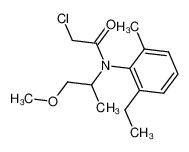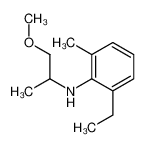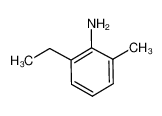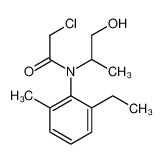1.Identification
1.1 GHS Product identifier
| Product name | metolachlor |
|---|
1.2 Other means of identification
| Product number | - |
|---|---|
| Other names | Metolachlor |
1.3 Recommended use of the chemical and restrictions on use
| Identified uses | For industry use only. Herbicide |
|---|---|
| Uses advised against | no data available |
1.4 Supplier's details
| Company | MOLBASE (Shanghai) Biotechnology Co., Ltd. |
|---|---|
| Address | Floor 4 & 5, Building 12, No. 1001 North Qinzhou Road, Xuhui District, Shanghai, China |
| Telephone | +86(21)64956998 |
| Fax | +86(21)54365166 |
1.5 Emergency phone number
| Emergency phone number | +86-400-6021-666 |
|---|---|
| Service hours | Monday to Friday, 9am-5pm (Standard time zone: UTC/GMT +8 hours). |
2.Hazard identification
2.1 Classification of the substance or mixture
Skin sensitization, Category 1
Hazardous to the aquatic environment, short-term (Acute) - Category Acute 1
Hazardous to the aquatic environment, long-term (Chronic) - Category Chronic 1
2.2 GHS label elements, including precautionary statements
| Pictogram(s) |   |
|---|---|
| Signal word | Warning |
| Hazard statement(s) | H317 May cause an allergic skin reaction H410 Very toxic to aquatic life with long lasting effects |
| Precautionary statement(s) | |
| Prevention | P261 Avoid breathing dust/fume/gas/mist/vapours/spray. P272 Contaminated work clothing should not be allowed out of the workplace. P280 Wear protective gloves/protective clothing/eye protection/face protection. P273 Avoid release to the environment. |
| Response | P302+P352 IF ON SKIN: Wash with plenty of water/... P333+P313 If skin irritation or rash occurs: Get medical advice/attention. P321 Specific treatment (see ... on this label). P362+P364 Take off contaminated clothing and wash it before reuse. P391 Collect spillage. |
| Storage | none |
| Disposal | P501 Dispose of contents/container to ... |
2.3 Other hazards which do not result in classification
none
3.Composition/information on ingredients
3.1 Substances
| Chemical name | Common names and synonyms | CAS number | EC number | Concentration |
|---|---|---|---|---|
| metolachlor | metolachlor | 51218-45-2 | none | 100% |
4.First-aid measures
4.1 Description of necessary first-aid measures
General advice
Consult a physician. Show this safety data sheet to the doctor in attendance.
If inhaled
Fresh air, rest.
In case of skin contact
Rinse and then wash skin with water and soap.
In case of eye contact
First rinse with plenty of water for several minutes (remove contact lenses if easily possible), then refer for medical attention.
If swallowed
Give one or two glasses of water to drink. Refer for medical attention .
4.2 Most important symptoms/effects, acute and delayed
Can cause skin irritation and eye irritation. Headache and nausea may occur following prolong exposure. (USCG, 1999)
4.3 Indication of immediate medical attention and special treatment needed, if necessary
There is no specific antidote to counteract the toxic affects of metolachlor ... Laboratory studies have shown that metolachlor has a high affinity for activated charcoal. Therefore, if ingestion is less than 10 mg/kg body wt, it is probably best treated by administering 30-50 gm of activated charcoal in 3-4 oz of water.
5.Fire-fighting measures
5.1 Extinguishing media
Suitable extinguishing media
Dry sand, alcohol-resistant foam, carbon dioxide.
5.2 Specific hazards arising from the chemical
no data available
5.3 Special protective actions for fire-fighters
Wear self-contained breathing apparatus for firefighting if necessary.
6.Accidental release measures
6.1 Personal precautions, protective equipment and emergency procedures
Use personal protective equipment. Avoid dust formation. Avoid breathing vapours, mist or gas. Ensure adequate ventilation. Evacuate personnel to safe areas. Avoid breathing dust. For personal protection see section 8.
6.2 Environmental precautions
Do NOT let this chemical enter the environment. Collect leaking and spilled liquid in covered containers as far as possible. Then store and dispose of according to local regulations. Personal protection: P2 filter respirator for harmful particles.
6.3 Methods and materials for containment and cleaning up
... Remove all ignition sources. Ventilate area of spill or leak. Absorb liquids in vermiculite, dry sand, earth, peat, carbon, or a similar material and deposit in sealed containers. Keep this chemical out of a confined space such as a sewer, because of the possibility of an explosion, unless the sewer is designed to prevent the build-up of explosive concentrations. ...
7.Handling and storage
7.1 Precautions for safe handling
Avoid contact with skin and eyes. Avoid formation of dust and aerosols. Avoid exposure - obtain special instructions before use.Provide appropriate exhaust ventilation at places where dust is formed. For precautions see section 2.2.
7.2 Conditions for safe storage, including any incompatibilities
Separated from food and feedstuffs. Well closed. Provision to contain effluent from fire extinguishing.Do not contaminate water, food or feed by storage ... Keep container closed to prevent spills and contamination. Store in original container. /Me-Too-Lachlor Herbicide/
8.Exposure controls/personal protection
8.1 Control parameters
Occupational Exposure limit values
no data available
Biological limit values
no data available
8.2 Appropriate engineering controls
Handle in accordance with good industrial hygiene and safety practice. Wash hands before breaks and at the end of workday.
8.3 Individual protection measures, such as personal protective equipment (PPE)
Eye/face protection
Safety glasses with side-shields conforming to EN166. Use equipment for eye protection tested and approved under appropriate government standards such as NIOSH (US) or EN 166(EU).
Skin protection
Wear impervious clothing. The type of protective equipment must be selected according to the concentration and amount of the dangerous substance at the specific workplace. Handle with gloves. Gloves must be inspected prior to use. Use proper glove removal technique(without touching glove's outer surface) to avoid skin contact with this product. Dispose of contaminated gloves after use in accordance with applicable laws and good laboratory practices. Wash and dry hands. The selected protective gloves have to satisfy the specifications of EU Directive 89/686/EEC and the standard EN 374 derived from it.
Respiratory protection
Wear dust mask when handling large quantities.
Thermal hazards
no data available
9.Physical and chemical properties
| Physical state | Pure metolachlor is light yellow oily liquit |
|---|---|
| Colour | Colorless liquid |
| Odour | no data available |
| Melting point/ freezing point | -62.1°C |
| Boiling point or initial boiling point and boiling range | 406.8ºC at 760 mmHg |
| Flammability | Combustible. |
| Lower and upper explosion limit / flammability limit | no data available |
| Flash point | greater than 110°C (USCG, 1999) |
| Auto-ignition temperature | 265.56°C (USCG, 1999) |
| Decomposition temperature | no data available |
| pH | no data available |
| Kinematic viscosity | no data available |
| Solubility | Miscible with benzene, toluene, ethanol, acetone, xylene, hexane, dimethylformamide, dichloroethane, cyclohexanone, methanol, octanol, and dichloromethane. Insoluble in ethylene glycol, propylene glycol, and petroleum ether. |
| Partition coefficient n-octanol/water (log value) | log Kow = 3.13 |
| Vapour pressure | 3.14X10-5 mm Hg at 25°C |
| Density and/or relative density | 1.1 g/cm3 |
| Relative vapour density | no data available |
| Particle characteristics | no data available |
10.Stability and reactivity
10.1 Reactivity
no data available
10.2 Chemical stability
Stable up to about 275°C.
10.3 Possibility of hazardous reactions
This chemical is a combustible liquid. ...METOLACHLOR is a chlorinated acetamide. May react with azo and diazo compounds to generate toxic gases. May form flammable gases with strong reducing agents. Combustion generates mixed oxides of nitrogen (NOx).
10.4 Conditions to avoid
no data available
10.5 Incompatible materials
Oxidizers, strong acids, nitrates.
10.6 Hazardous decomposition products
When heated to decompostion it emits toxic fumes of /hydrogen chloride and nitrogen oxides/.
11.Toxicological information
Acute toxicity
- Oral: LD50 Rat oral 2877 mg/kg bw
- Inhalation: LC50 Rat inhalation >2.02 mg/L/4 hr air
- Dermal: no data available
Skin corrosion/irritation
no data available
Serious eye damage/irritation
no data available
Respiratory or skin sensitization
no data available
Germ cell mutagenicity
no data available
Carcinogenicity
Cancer Classification: Group C Possible Human Carcinogen
Reproductive toxicity
no data available
STOT-single exposure
no data available
STOT-repeated exposure
no data available
Aspiration hazard
no data available
12.Ecological information
12.1 Toxicity
- Toxicity to fish: LC50; Species: Oncorhynchus mykiss (Rainbow Trout); Conditions: freshwater, static; Concentration: 3900 ug/L for 96 hr (95% confidence interval: 3300-4600 ug/L)
- Toxicity to daphnia and other aquatic invertebrates: EC50; Species: Daphnia magna (Water Flea) 1st instar larva; Conditions: freshwater, static; Concentration: 25100 ug/L for 48 hr (95% confidence interval: 21600-29200 ug/L); Effect: intoxication, immobilization
- Toxicity to algae: EC50; Species: Anabaena flosaquae (Blue-Green Algae); Conditions: freshwater, static; Concentration: 1200 ug/L for 5 days (95% confidence interval: 900-1600 ug/L); Effect: population abundance /97.3% purity
- Toxicity to microorganisms: no data available
12.2 Persistence and degradability
AEROBIC: Under aerobic soil conditions, metolachlor degraded with a half-life of 67 days in a sandy loam soil(1). The rate of degradation of metolachlor in soil increases with an increase in soil moisture content, temperature and microbial activity(2,3). The degradation of metolachlor is slower in subsoils than in surface soil(2). Five metabolites of metolachlor including 2-chloro-N-(2-ethyl-6-methylphenyl)-N-(hydroxyprop-2-yl)acetamide have been identified in soil(2). The aerobic aquatic biodegradation half-life of metolachlor was 47 days(1). The disappearance of metolachlor in groundwater free of aquifer materials (e.g., sand) was very slow(4,5). After a lag period of 10-12 months, metolachlor degraded with half-lives of 548-1074 days(5). In a study examining soils from agrochemical dealerships or railroad rights-of-way in central Iowa, rhizosphere soil samples, representing four plant families, were not able to mineralize large quantities (>8.5%) of 14C-metolachlor after 50 days(6). Samples were incubated in the dark at 20°C with a metolachlor concentration of 50 ug/g(6). However, in a 14-day environmental chamber study with a 14 hr photoperiod, degradation of 10 ppm metolachlor, present as a mixture with trifluralin and atrazine, was shown to occur in non-vegetated soil (27% degradation) but not to the extent of the Kochia scoparia rhizosphere soil (48% degradation), suggesting that the rhizosphere of certain plant species may facilitate microbial degradation(7). Metolachlor was not biodegraded in contaminated soil from an agrochemical dealership in Iowa, 50 ug/g initial concentration (background concentration averaged 7 ug/g) had ending concentrations of 43 to 60 ug/g metolachlor after 160 days of incubation at 25°C in the dark(8).
12.3 Bioaccumulative potential
A whole body BCF for metolachlor in catfish (Ictalurus melas) was experimentally determined to be <1(1). The time required to attain equilibrium in catfish was found to be 3-4 days; and the depuration half-life in catfish was 1.2 days(1). In another study, a whole body metolachlor BCF of 69 was reported for fish, with a whole body elimination of 93% after 14 days depuration(2). A whole body BCF for metolachlor in bluegill (Lepomic macrochirus) exposed for 28 days was 74(3). Catfish BCFs of metolachlor were 6.5-9.0 for edible portions and 55-99 for viscera after a 30 day exposure(4). According to a classification scheme(5), these BCF values suggest bioconcentration in aquatic organisms is low to moderate(SRC).
12.4 Mobility in soil
Koc values for metolachlor have been reported to range from 22 to 2320(1-3). In an 80 day field study using tropical soils of Brazil, Koc values were measured for metolachlor; Ustox soil (42.9-54.0% clay, 2.5-4.3% silt, 42.4-54.6% sand, 1.63-3.06% organic carbon) had an initial Koc of 186 and maximum Koc of 1530; Psamments soil (9.7-14.4% clay, 1.0-1.8% silt, 84.6-88.5% sand, 0.71-1.01% organic carbon) had an initial Koc of 122 and maximum Koc of 2320(1). Koc values for clay (4.8% organic matter, 42% clay and pH 5.9), sand (0.9% organic matter, 2.2% clay, and pH 6.5), sandy loam (5% organic matter, 9.2% clay, and pH 5.9), and loam (1.2% organic matter, 11.2% clay, and pH 7.6) soils are 68, 22, 74, and 110, respectively(2). Vegetative filter strip soil (37.9% sand, 31.9% silt, 30.2% clay, 4.2% organic carbon, pH 7.6) and cultivated soil (36.8% sand, 29.5% silt, 33.7% clay, 2.5% organic carbon, pH 7.6) from Texas had measured Koc values for metolachlor of 195.9 and 173.7, respectively(3). According to a classification scheme(4), these Koc values suggest that metolachlor is expected to have very high to slight mobility in soil(SRC). Metolachlor adsorbs more readily to muck or clay soils than to soils with low organic matter and clay content, and adsorbs more readily to organic matter than to clay(2). Experimental leaching and soil thin layer plate studies have shown that metolachlor absorbs weakly to moderately to soil and the leaching of metolachlor from soil is high to medium(5,6). In field experiments conducted with soybeans grown in Wisconsin, and corn in Iowa and California, no quantifiable metolachlor residues (limit of detection = 50 ppb) were found below 45 cm (18 in)(2). Leaching of metolachlor is generally not expected when soil organic matter is >2%(2). Leaching potentials were measured in six soil types on the Canary Island of Tenerife, potentials were 0.107 to 0.303 and is considered a leacher (> or = 0.2 to < or = 1)(7). Metolachlor had Kd values of 130.3, 32.9 and 30.9 mL/g with Bermuda grass, Weswood soil (course-silty, mixed, thermic, Fluventic Ustocherpt) and Houston black soil (fine, montmorilliontic, thermic, Udic Pellustert), respectively(8). Log Kom values ranged from 0.98 to 2.17 in 33 surface soils from Salamanca, Spain with a pH range of 4.4 to 7.7 and organic matter range of 0.43 to 2.59%(9).
12.5 Other adverse effects
no data available
13.Disposal considerations
13.1 Disposal methods
Product
The material can be disposed of by removal to a licensed chemical destruction plant or by controlled incineration with flue gas scrubbing. Do not contaminate water, foodstuffs, feed or seed by storage or disposal. Do not discharge to sewer systems.
Contaminated packaging
Containers can be triply rinsed (or equivalent) and offered for recycling or reconditioning. Alternatively, the packaging can be punctured to make it unusable for other purposes and then be disposed of in a sanitary landfill. Controlled incineration with flue gas scrubbing is possible for combustible packaging materials.
14.Transport information
14.1 UN Number
| ADR/RID: UN1648 | IMDG: UN1648 | IATA: UN1648 |
14.2 UN Proper Shipping Name
| ADR/RID: ACETONITRILE |
| IMDG: ACETONITRILE |
| IATA: ACETONITRILE |
14.3 Transport hazard class(es)
| ADR/RID: 3 | IMDG: 3 | IATA: 3 |
14.4 Packing group, if applicable
| ADR/RID: II | IMDG: II | IATA: II |
14.5 Environmental hazards
| ADR/RID: yes | IMDG: yes | IATA: yes |
14.6 Special precautions for user
no data available
14.7 Transport in bulk according to Annex II of MARPOL 73/78 and the IBC Code
no data available
15.Regulatory information
15.1 Safety, health and environmental regulations specific for the product in question
| Chemical name | Common names and synonyms | CAS number | EC number |
|---|---|---|---|
| metolachlor | metolachlor | 51218-45-2 | none |
| European Inventory of Existing Commercial Chemical Substances (EINECS) | Listed. | ||
| EC Inventory | Listed. | ||
| United States Toxic Substances Control Act (TSCA) Inventory | Not Listed. | ||
| China Catalog of Hazardous chemicals 2015 | Not Listed. | ||
| New Zealand Inventory of Chemicals (NZIoC) | Listed. | ||
| Philippines Inventory of Chemicals and Chemical Substances (PICCS) | Not Listed. | ||
| Vietnam National Chemical Inventory | Listed. | ||
| Chinese Chemical Inventory of Existing Chemical Substances (China IECSC) | Not Listed. | ||
16.Other information
Information on revision
| Creation Date | Aug 14, 2017 |
|---|---|
| Revision Date | Aug 14, 2017 |
Abbreviations and acronyms
- CAS: Chemical Abstracts Service
- ADR: European Agreement concerning the International Carriage of Dangerous Goods by Road
- RID: Regulation concerning the International Carriage of Dangerous Goods by Rail
- IMDG: International Maritime Dangerous Goods
- IATA: International Air Transportation Association
- TWA: Time Weighted Average
- STEL: Short term exposure limit
- LC50: Lethal Concentration 50%
- LD50: Lethal Dose 50%
- EC50: Effective Concentration 50%
References
- IPCS - The International Chemical Safety Cards (ICSC), website: http://www.ilo.org/dyn/icsc/showcard.home
- HSDB - Hazardous Substances Data Bank, website: https://toxnet.nlm.nih.gov/newtoxnet/hsdb.htm
- IARC - International Agency for Research on Cancer, website: http://www.iarc.fr/
- eChemPortal - The Global Portal to Information on Chemical Substances by OECD, website: http://www.echemportal.org/echemportal/index?pageID=0&request_locale=en
- CAMEO Chemicals, website: http://cameochemicals.noaa.gov/search/simple
- ChemIDplus, website: http://chem.sis.nlm.nih.gov/chemidplus/chemidlite.jsp
- ERG - Emergency Response Guidebook by U.S. Department of Transportation, website: http://www.phmsa.dot.gov/hazmat/library/erg
- Germany GESTIS-database on hazard substance, website: http://www.dguv.de/ifa/gestis/gestis-stoffdatenbank/index-2.jsp
- ECHA - European Chemicals Agency, website: https://echa.europa.eu/







